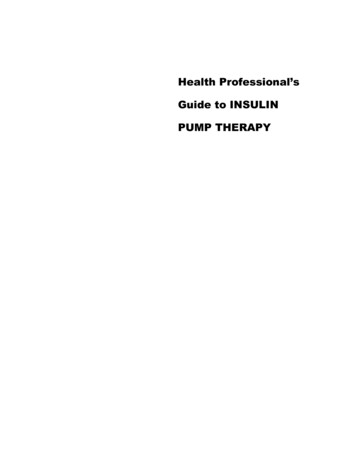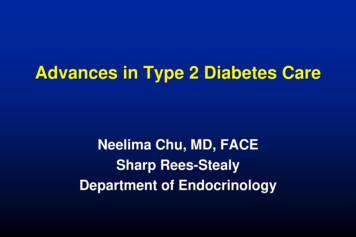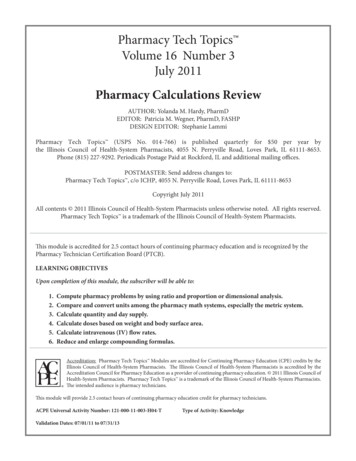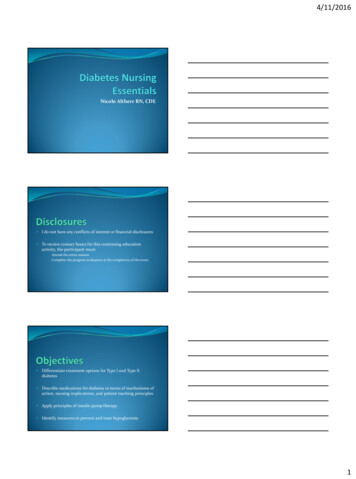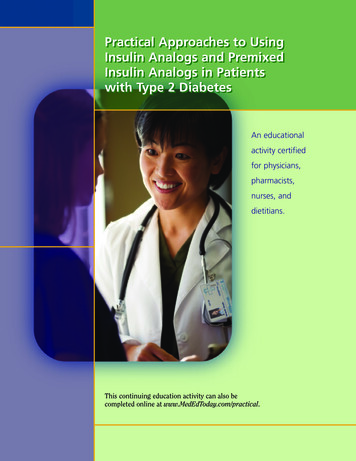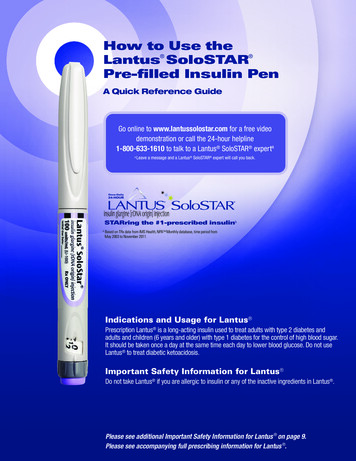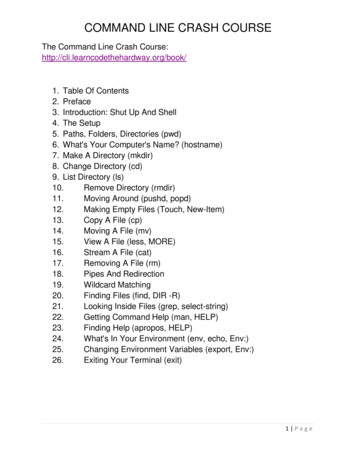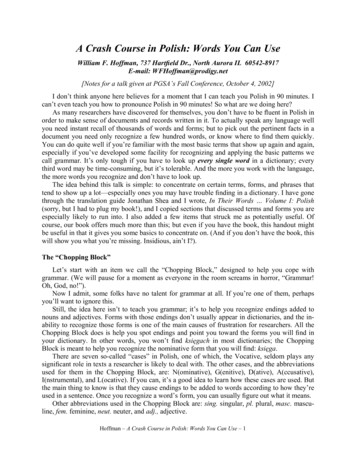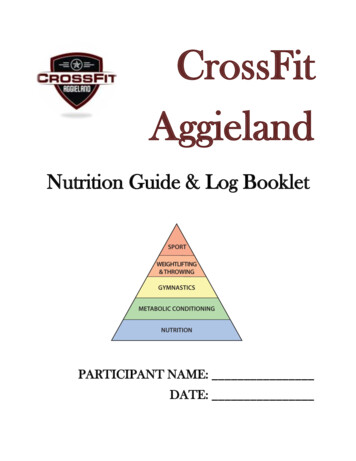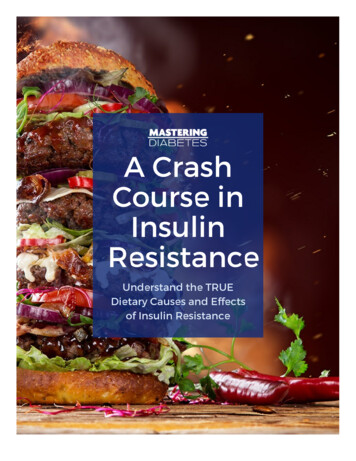
Transcription
A CrashCourse inInsulinResistanceUnderstand the TRUEDietary Causes and Effectsof Insulin Resistance
The Causes of InsulinResistance in Type 1and Type 2 DiabetesInsulin resistance is the common thread that underlies allforms of diabetes. In this ebook, you'll find out exactly why.Most people believe that people with type 1 diabetes are not insulinresistant simply because they are not overweight. This could not befarther from the truth.While insulin resistance affects many overweight individuals, manypeople with type 1 diabetes remain skinny their entire lives despite alarge degree of insulin resistance (1–3).Over the past decade, we have helped many people with type 1 diabetes,prediabetes and type 2 diabetes measure, track and reverse insulinresistance. In practice, 100% of all our clients with type 1 diabetes sufferfrom insulin resistance despite the assumption that they were insulinsensitive.By measuring their baseline insulin resistance, we were able to identify animpaired ability to utilize glucose as a fuel, and through dedicated dietmodification and frequent exercise, some of our clients have reducedtheir insulin usage by as much as 60%.If you have type 1 diabetes, do not be fooled into thinking that you areinsulin sensitive simply because you are skinny. Insulin resistance is ahidden condition, and affects both normal weight and overweightindividuals (1–3).
What Causes Insulin Resistance?Insulin resistance underlies all forms of diabetes, and is a condition whichprimarily affects your muscles, liver and adipose tissue.Many people think that diabetes is caused by an excess intake of sugarand candy starting from a young age. While eating artificial sweetenersand drinking soda can certainly increase your risk for the development ofinsulin resistance and diabetes, in most cases diabetes is caused byexcessive FAT intake.The most important thing you can do as a person with diabetes isunderstand the following:Diabetes is caused by a fat metabolism disorder,which results in a glucose metabolism disorder. Atthe heart of all forms of diabetes is insulin resistance,a condition fueled primarily by the intake andaccumulation of excess fat across many tissues.This concept is one of the most fundamental realities that cansignificantly improve your ability to control blood glucose. While mostdiabetes education will instruct you to count and minimize yourcarbohydrate intake, this does nothing to treat the underlying conditionof insulin resistance.In fact, minimizing carbohydrate intake results in an increase in fatintake, which makes you more insulin resistant over time. Minimizingcarbohydrate intake only treats the symptoms of diabetes (high bloodsugar), and often results in increased insulin resistance over time.Importantly, insulin resistance is a risk factor for many chronic healthconditions, including heart disease, high blood pressure (hypertension),high cholesterol, cancer, diabetes, Alzheimer’s disease, kidney failure,stroke and nerve damage.
Unfortunately, insulin resistance is grossly misunderstood, and as a resultthere are many fad diets that claim to improve overall health but actuallyincrease insulin resistance. As a consumer, it is very challenging tounderstand exactly what information to ingest and what information todisregard. Food manufacturers take advantage of this, and intentionallydeceive people into buying their products.But you are highly intelligent, highly motivated and are capable ofapplying these powerful methods to your daily life, and experience thedifference that it makes first hand. By directly reducing your level ofinsulin resistance, you will improve the health of every organ in yourbody, to prevent against the conditions listed in the following diagram:
Low-Carb Diets are High-Fat Diets byDefinitionA wealth of evidence supports the concept that insulin resistance resultsfrom the accumulation of excess fatty acids in tissues that are notdesigned to store fat, such as the liver and muscle. As these tissuesaccumulate fat over time, they experience cellular distress andmitochondrial dysfunction, which then results in a significantly impairedability to respond to insulin (4–27).There are a few fundamental problems with the no-carb or low-carbstrategy that is specifically designed to reduce your intake of glucose (theprimary breakdown product of carbohydrates):Glucose is a molecule which can be used by every tissue in the bodyfor immediate energyGlucose is the very molecule that body tissues are designed to use asfuelLimiting carbohydrate intake results in the consumption of highamounts of protein and fat, which promote increased fat storage andexacerbate insulin resistanceEating large quantities fat directly blocks the action of insulin in themuscle and liverLet’s discuss the 3 causes of insulin resistance in detail.
Insulin Resistance Cause #1: Lipid OverloadThere is only one tissue in your body that is designed to store fat, and thattissue is called adipose tissue (fat tissue). Fat tissue is perfectly designedto uptake, store and export fatty acids, and possesses all of the enzymaticmachinery to do so.Most importantly, fat tissue is an elastic tissue which expands andcontracts in response to periods of high and low fatty acid availability.When fatty acids are available, adipose tissue expands.When fatty acids are limiting, adipose tissue contracts.This very elastic behavior of adipose tissue is exactly what results inweight gain and weight loss, and can be manipulated to your advantageif weight loss is your long-term goal.Insulin Resistance Cause #2: RefinedCarbohydratesWe’ve all heard that you should eat less sugar, and eliminate foodadditives like high fructose corn syrup, because they increase your risk forcancer, heart disease and diabetes. But why is that the case?One simple way that refined carbohydrates promote diabetes isspecifically by causing insulin resistance in the liver. Think of your liver asa glucose sponge, whose responsibility is to uptake glucose when it firstappears in your bloodstream. In this way, your liver is actually protectingother tissues against large glucose surges following a carbohydrate-richmeal.
If you haven’t done so already, thank your liver for acting as a glucosesponge every time you eat carbohydrates – it is literally sparing othertissues from metabolic damage caused by the rapid appearance ofglucose.When you eat refined carbohydrates - most often disguised as sugarnymsin packaged and processed food products – the breakdown products ofthese artificial sweeteners (mainly glucose and fructose) flood your liverimmediately.Insulin Resistance Cause #3: InsufficientMovementMitochondria are cellular organelles that function as cellular powerplants. In the same way that a power plant produces electricity for a city,mitochondria are responsible for the production of energy derived fromthe breakdown of carbohydrates and fatty acids.
Mitochondria oxidize or “burn” carbohydrates, amino acids and fattyacids for energy, yielding ATP. ATP is the cellular form of energy utilizedby cellular processes all throughout the body, providing the energy topump your heart, power neurons in your brain, contract muscles in yourlimbs, exchange gases in your lungs, extract nutrients from food andregulate body temperature, to name just a few.Insufficient movementresults in low mitochondrial number and a reduced ability to “burn” fuels.As a result, the muscle tissue is prone to accumulating fatty acids astriglycerides, resulting in insulin resistance.Since muscle tissue occupies more than 40% of the human body bymass, a reduced ability of muscle mitochondria to burn fatty acids andglucose for energy is partly responsible for feelings of low energy andsluggishness that many people with diabetes experience.Insulin resistance is a metabolic disaster for muscle tissue, and reversinginsulin resistance involves the direct “reprogramming” of musclemitochondria.More importantly, defective muscle mitochondrial function ofteninduces a mild inflammatory state within the muscle tissue that resultsin the production of blood borne myokines that signal a state of stress tocirculating immune cells.Take Home MessagesThe take home message of this article is simple: insulin resistance has 3very clear causes, and taking a series of specific actions can result insignificantly increased insulin sensitivity in a short period of time.If you have type 1 diabetes, do not be mistaken into thinking that youare insulin sensitive simply because you are normal weight or skinny.If you have type 2 diabetes, insulin resistance is the underlying causeof high blood sugar.
References1. Szadkowska A, Pietrzak I, Mianowska B, Markuszewski L, BodalskaLipińska J, Bodalski J. . Endokrynol Diabetol Chor Przemiany MateriiWieku Rozw Organ Pol Tow Endokrynol Dziecięcych. 2006;12(2):109–15.2. Reinehr T, Holl RW, Roth CL, Wiesel T, Stachow R, Wabitsch M, et al.Insulin resistance in children and adolescents with type 1 diabetesmellitus: relation to obesity. Pediatr Diabetes. 2005 Mar;6(1):5–12.3. Bergman BC, Howard D, Schauer IE, Maahs DM, Snell-Bergeon JK,Eckel RH, et al. Features of hepatic and skeletal muscle insulinresistance unique to type 1 diabetes. J Clin Endocrinol Metab. 2012May;97(5):1663–72.4. Roden M. How free fatty acids inhibit glucose utilization in humanskeletal muscle. News Physiol Sci Int J Physiol Prod Jointly Int UnionPhysiol Sci Am Physiol Soc. 2004 Jun;19:92–6.5. Silveira LR, Fiamoncini J, Hirabara SM, Procópio J, Cambiaghi TD,Pinheiro CHJ, et al. Updating the effects of fatty acids on skeletalmuscle. J Cell Physiol. 2008 Oct;217(1):1–12.6. Brehm A, Krssak M, Schmid AI, Nowotny P, Waldhäusl W, Roden M.Increased lipid availability impairs insulin-stimulated ATP synthesis inhuman skeletal muscle. Diabetes. 2006 Jan;55(1):136–40.7. Roden M, Price TB, Perseghin G, Petersen KF, Rothman DL, Cline GW, etal. Mechanism of free fatty acid-induced insulin resistance in humans.J Clin Invest. 1996 Jun 15;97(12):2859–65.8. Shulman GI. Cellular mechanisms of insulin resistance. J Clin Invest.2000 Jul;106(2):171–6.9. Randle PJ, Garland PB, Hales CN, Newsholme EA. The glucose fattyacid cycle. Its role in insulin sensitivity and the metabolic disturbancesof diabetes mellitus. Lancet. 1963 Apr 13;1(7285):785–9.10. Hirabara SM, Silveira LR, Alberici LC, Leandro CVG, Lambertucci RH,Polimeno GC, et al. Acute effect of fatty acids on metabolism andmitochondrial coupling in skeletal muscle. Biochim Biophys Acta.2006 Jan;1757(1):57–66.11. Massao Hirabara S, de Oliveira Carvalho CR, Mendonça JR, PiltcherHaber E, Fernandes LC, Curi R. Palmitate acutely raises glycogensynthesis in rat soleus muscle by a mechanism that requires itsmetabolization (Randle cycle). FEBS Lett. 2003 Apr 24;541(1-3):109–14.12. Hirabara SM, Curi R, Maechler P. Saturated fatty acid-induced insulinresistance is associated with mitochondrial dysfunction in skeletalmuscle cells. J Cell Physiol. 2010 Jan;222(1):187–94.
13. Hirabara SM, Silveira LR, Abdulkader F, Carvalho CRO, Procopio J, CuriR. Time-dependent effects of fatty acids on skeletal musclemetabolism. J Cell Physiol. 2007 Jan;210(1):7–15.14. Yuzefovych L, Wilson G, Rachek L. Different effects of oleate vs.palmitate on mitochondrial function, apoptosis, and insulin signalingin L6 skeletal muscle cells: role of oxidative stress. Am J PhysiolEndocrinol Metab. 2010 Dec;299(6):E1096–105.15. Yu C, Chen Y, Cline GW, Zhang D, Zong H, Wang Y, et al. Mechanism bywhich fatty acids inhibit insulin activation of insulin receptorsubstrate-1 (IRS-1)-associated phosphatidylinositol 3-kinase activity inmuscle. J Biol Chem. 2002 Dec 27;277(52):50230–6.16. Griffin ME, Marcucci MJ, Cline GW, Bell K, Barucci N, Lee D, et al. Freefatty acid-induced insulin resistance is associated with activation ofprotein kinase C theta and alterations in the insulin signaling cascade.Diabetes. 1999 Jun;48(6):1270–4.17. Funai K, Song H, Yin L, Lodhi IJ, Wei X, Yoshino J, et al. Musclelipogenesis balances insulin sensitivity and strength through calciumsignaling. J Clin Invest. 2013 Mar 1;123(3):1229–40.18. Delarue J, Magnan C. Free fatty acids and insulin resistance. Curr OpinClin Nutr Metab Care. 2007 Mar;10(2):142–8.19. Martins AR, Nachbar RT, Gorjao R, Vinolo MA, Festuccia WT,Lambertucci RH, et al. Mechanisms underlying skeletal muscle insulinresistance induced by fatty acids: importance of the mitochondrialfunction. Lipids Health Dis. 2012;11:30.20. Wang P-Y, Kaneko T, Wang Y, Tawata M, Sato A. Impairment of GlucoseTolerance in Normal Adults Following a Lowered Carbohydrate Intake.Tohoku J Exp Med. 1999;189(1):59–70.21. Xiao C, Giacca A, Carpentier A, Lewis GF. Differential effects ofmonounsaturated, polyunsaturated and saturated fat ingestion onglucose-stimulated insulin secretion, sensitivity and clearance inoverweight and obese, non-diabetic humans. Diabetologia. 2006 Apr5;49(6):1371–9.22. Wolpert HA, Atakov-Castillo A, Smith SA, Steil GM. Dietary Fat AcutelyIncreases Glucose Concentrations and Insulin Requirements inPatients With Type 1 Diabetes Implications for carbohydrate-basedbolus dose calculation and intensive diabetes management. DiabetesCare. 2013 Apr 1;36(4):810–6.23. Savage DB, Petersen KF, Shulman GI. Disordered Lipid Metabolism andthe Pathogenesis of Insulin Resistance. Physiol Rev. 2007 Apr1;87(2):507–20.
24. Risérus U, Willett WC, Hu FB. Dietary fats and prevention of type 2diabetes. Prog Lipid Res. 2009 Jan;48(1):44–51.25. Pańkowska E, Błazik M, Groele L. Does the fat-protein meal increasepostprandial glucose level in type 1 diabetes patients on insulin pump:the conclusion of a randomized study. Diabetes Technol Ther. 2012Jan;14(1):16–22.26. Gormsen LC, Nielsen C, Jessen N, Jørgensen JOL, Møller N. Time-courseeffects of physiological free fatty acid surges on insulin sensitivity inhumans. Acta Physiol Oxf Engl. 2011 Mar;201(3):349–56.27. Boden G. Fatty acid-induced inflammation and insulin resistance inskeletal muscle and liver. Curr Diab Rep. 2006 Jun;6(3):177–81.28. Hellerstein MK, Schwarz JM, Neese RA. Regulation of hepatic de novolipogenesis in humans. Annu Rev Nutr. 1996;16:523–57.29. Hellerstein MK. De novo lipogenesis in humans: metabolic andregulatory aspects. Eur J Clin Nutr. 1999 Apr;53 Suppl 1:S53–65.30. Stanhope KL, Schwarz JM, Keim NL, Griffen SC, Bremer AA, Graham JL,et al. Consuming fructose-sweetened, not glucose-sweetened,beverages increases visceral adiposity and lipids and decreases insulinsensitivity in overweight/obese humans. J Clin Invest. 2009May;119(5):1322–34.
Looking for aDiabetes Coach toHelp You Transition?If you're looking for education, guidance, and accountabilityto help you transition to a plant-based diet for the BESTdiabetes health you've ever had, sign up for a free strategysession to see if you're a good fit for an online groupcoaching program (type 1, type 1.5, prediabetes and type 2diabetes).BOOK A FREE STRATEGY SESSION
mellitus: relation to obesity. Pediatr Diabetes. 2005 Mar;6(1):5–12. 3. Bergman BC, Howard D, Schauer IE, Maahs DM, Snell-Bergeon JK, Eckel RH, et al. Features of hepatic and skeletal muscle insulin resistance unique to type 1 diabetes. J Clin Endocrinol Metab. 2012 May;97(5):1663–72. 4. Roden M.
